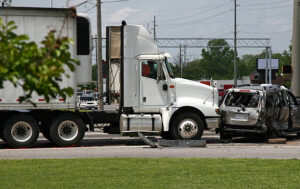For most fleets, safety is a top priority. After all, reputable motor carriers don’t operate under the assumption of, “Well, if they don’t catch us, it’s OK.”
Unfortunately, it’s all too easy to acquire blemishes on a safety record, even for the most cautious of carriers. From properly secured cargo to accurate record keeping and vehicle maintenance, there are dozens of things that can go wrong if fleet managers aren’t on top of equipment maintenance and driver training.
Let’s be honest: It’s rare for a carrier to maintain a completely spotless safety record.
A poor safety record often translates to issues that can seriously impact a company’s bottom line, from equipment and driver violation fees to expensive lawsuits when drivers are involved in at-fault accidents. And, of course, insurance providers keep track of motor carriers’ “report cards.” A bad grade can easily result in higher premiums.
So, how can a carrier with a less-than-perfect record turn things around?
Invest in training.
During a 2023 interview on the Tenney Group’s “In the Hot Seat” YouTube series, Brandon Wiseman, president of Trucksafe Consulting, noted that systematic problems with safety are often due to a lack of education on the part of various levels of a carrier.
“You can’t get ahold of problems unless you understand what’s going on,” he said, adding that education and training is key to helping companies identify and resolve issues.
For instance, he said, if a carrier is having constant issues with its drivers’ hours of service (HOS), “there is no substitute for bringing drivers in and giving them additional training on this requirement. You have to help them understand where things are going wrong.”
Drivers aren’t the only team members who may require updated training. Safety team members and company owners can also benefit from a refresher course in rules and regulations.
Make safety a top priority.
Chris Gulker, senior vice president of transportation at TrueNorth, says safety is paramount — or at least it should be — for all carriers.
“This is deeply embedded into the culture and day to day mindset, culture, and day-to-day practices of industry-leading companies,” he said. “Because safety is such a critical concern in the transportation industry, restoring creditability by rebuilding trust and credibility will require time, strategic planning, and commitment from all levels of the organization.”
Gulker says this should involve a comprehensive approach that addresses all aspects of the business, including operations, finance, leadership, safety, recruiting — a true team effort across the enterprise.
If a company finds itself in trouble, there are steps that can be taken to right the ship, Gulker said.
“The first step in a company restoring a safety reputation is establishing commitment from the entire leadership team,” he said. “For true, long-lasting change to occur, a demonstrated commitment to safety is required by all levels of the organization. Safety needs to be given priority in the day-to-day decision making, and it starts with the most senior leaders.”
Once a thorough assessment has been completed, a comprehensive risk management strategy needs to be developed, communicated to the organization, and deployed. While there’s never a one-size-fits-all solution, Gulker says, the following strategies can help:
- Create a safety mission statement that is communicated on a regular basis to the entire organization. This is a foundational step to creating a true culture of safety.
- Establish three to five critical key performance indicators (KPIs) with target improvement goals to track performance in real-time. Providing KPIs at both the enterprise level and the “middle of the business” level (e.g., a terminal level) allows progress to be tracked and performance to be managed to drive results.
- Establish a cross-functional safety council that includes representatives from safety/risk, along with executive leadership, finance, and operations teams; safety/risk should have an equal seat at the table. This allows for open communication about problems and progress while also soliciting collaborative feedback across functions.
- Invest in comprehensive safety training at appropriate levels for all employees — executives, safety and compliance teams, dispatch, recruiting, orientation, drivers, etc.
- Implement safety technologies. Gulker says that, in recent years, safety technology innovations have developed at a staggering pace. Implementing state-of-art safety technology such as cameras, lane-deviation assistance, and active crash mitigation not only improves safety performance; it also drives down overall costs in the long term. Leveraging safety technology also allows companies to implement coaching / development programs and incentives for positive performance.
- Continue to improve. By continuously monitoring progress and ongoing safety performance, a company can evaluate whether the strategies are effective or if adjustments need to be made.
Take advantage of technology.
In a blog post entitled “FMCSA Regulations: A Guide for Fleet Managers” fleet operations company Samsara offered the following tips to keep fleets compliant with FMCSA regulations:
- Invest in an easy-to-use ELD solution. During roadside inspections (or if a fleet is ever audited), it’s important to be sure drivers’ HOS logs are accurate, complete, and easy to access. It’s important to choose an electronic logging device (ELD) solution that’s easy for drivers and compliance managers to use.
- Go paperless using electronic DVIRs. Still using paper driver vehicle inspection reports (DVIRs)? Now is the time to switch to digital. Because electronic driver vehicle inspection reports (eDVIRs) are digital, they make it easier to stay compliant with FMCSA regulations related to maintenance and vehicle safety. Drivers can submit eDVIRs right from the palm of their hand using an app; these apps are available from various providers. The eDVIRs instantly appear on a carrier’s online dashboard, positioned alongside preventive maintenance schedules, maintenance logs, and real-time vehicle statuses. This allows technicians to prioritize the most urgent issues and sign the eDVIR for the next driver to verify, completing the FMCSA requirement.
- Keep CSA scores low with dash cams. The FMCSA uses the compliance, safety and accountability (CSA) program to identify high-risk carriers and intervene. Sometimes the FMCSA will even put carriers with high CSA scores out of service until they can improve their compliance or safety procedures. One of the best ways to avoid FMCSA intervention is for a carrier to keep its CSA scores low.
The solution? Dash cams.
Dash cams are an extremely effective safety tool for commercial fleets. With better visibility into risky driving behavior (like speeding, distracted driving, and tailgating), carriers can more effectively coach drivers and prevent accidents. AI dash cams can automatically upload incident footage to the cloud, which makes it easy to exonerate drivers from not-at-fault accidents and avoid unnecessary marks to CSA scores.
Know “the right stuff.”
However, carriers that follow these measures and make sure their teams have access to proper education and training still sometimes find themselves behind the proverbial eight-ball when it comes to compliance. Wiseman says he’s not surprised.
“There are just so many regs out there,” he said. “There will be some gaps in understanding how these things apply to your fleet. So, first things first: You gotta make sure you have a foundational understanding of requirements for fleet education is big part of it.”
Being proactive is also key, he said.
“A lot of fleets are just trying to put out fires as they come to them,” he said.
“(I hear), ‘We have the DOT (Department of Transportation) knocking on the door for audit. What can we do to fix it?’” he continued. “It’s too late at that point to fix what they will discover in audit. Too many fleets are trying to survive, so they do what they gotta do, but spending a little time trying to close gaps can save a lot of trouble.”
This article originally appeared in the January/February 2024 edition of Truckload Authority, the official publication of the Truckload Carriers Association.
Linda Garner-Bunch has been in publishing for more than 30 years. You name it, Linda has written about it. She has served as an editor for a group of national do-it-yourself publications and has coordinated the real estate section of Arkansas’ only statewide newspaper, in addition to working on a variety of niche publications ranging from bridal magazines to high-school sports previews and everything in between. She is also an experienced photographer and copy editor who enjoys telling the stories of the “Knights of the Highway,” as she calls our nation’s truck drivers.








